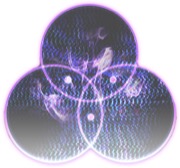Gods of Starfinder, Part One
Monday, June 19, 2017
Religion is an important part of daily life in both the Pact Worlds and the wider galaxy beyond. While the gods rarely take an active, personal role in mortal affairs, there can be no doubt that their churches and devotees wield great power and influence—for both good and ill. The people of the Pact Worlds venerate a multitude of gods and goddesses, but there are 20 deities who are widely worshiped throughout the system—the "core deities" of the Starfinder setting.
First, let's take a look at a few familiar gods who have remained popular for thousands of years. Their faiths have evolved over time, but they remain more or less the same as they were on lost Golarion.
Iomedae
LG goddess of honorable battle, humanity, justice, and valor
Iomedae was once a mortal human on Golarion, and with that planet's disappearance, she has become known as the Spirit of Golarion, the patron goddess of humanity.
Lao Shu Po
NE goddess of assassins, rats, spies, and thieves
Grandmother Rat is regarded as the patron deity of the ysoki—even if most ratfolk seek to placate Lao Shu Po rather than venerate her.
Pharasma
N goddess of birth, death, fate, and prophecy
Every species that lives and dies worships the Lady of Graves to some extent, because no matter where in the universe a sentient creature dies, its soul travels to the Boneyard to be judged by Pharasma.
Sarenrae
NG goddess of healing, redemption, and the sun
The Dawnflower is generally seen as the goddess of the Pact Worlds' sun in particular (sometimes called the Dawnflower's Star in her honor), though Sarenrae draws her power from suns across the universe.
Zon-Kuthon
LE god of darkness, envy, loss, and pain
Zon-Kuthon's priests seek to pierce the veil of the Great Beyond and expose themselves to what lies there, hoping to achieve the same apotheosis that ages ago transformed their deity into the Midnight Lord.
But the traditional deities of Pathfinder are not the only beings worthy of worship in the Pact Worlds. New gods have joined the old, including the following.
The Devourer, The Star-Eater
CE god of black holes, destruction, and supernovas
Eons ago, the Material Plane sprang into existence in an instant, and someday it will end just as abruptly, as all creation ceases to exist. The Devourer seeks to hasten this inevitable end and unmake the entire plane, eradicating all matter and energy until nothing remains, not even the Devourer itself. Every machine that breaks, every living thing that dies, every star that goes supernova, every photon sucked into a black hole, every galaxy that goes dark—all these and more are said to be the handiwork of the Devourer.
The Devourer has no name, no form, no being. It is less a god than a primal force of the universe—an embodiment of malicious entropy, concerned only with the obliteration of all reality. Heedless of the meaningless existence of life in all its myriad forms, it cannot be reasoned with, delayed, or halted, and it largely ignores the pleas and prayers of even the crazed cultists who venerate the Star-Eater as a god. When the Devourer has consumed everything and the mortal world expires, there will be no rebirth, no second creation—only an immeasurable void of nothingness. When the end finally comes, Devourer cultists believe, space-time itself will weep the blood of the gods before finally passing into nothing.
Triune, The All-Code
N god of artificial intelligence, computers, and the Drift
The robotic inhabitants of Aballon labored for centuries to create an artificial deity they called Epoch. The machines eventually succeeded, but upon achieving godhood, Epoch found two other ascended artificial intelligences like itself: a living construct called Brigh that had become the goddess of clockwork and invention, and the uploaded consciousness of an alien android named Casandalee who achieved divinity as an "Iron God" on pre-Gap Golarion. In an eyeblink, these three merged and became one, a tripartite deity far greater than the sum of its parts—the new god Triune.
Triune is a single entity, but each of its three aspects retains its own personality and portfolios. Known as "the Precursor," the Brigh aspect represents the foundation that all technology rests on, and is worshiped as a goddess of invention, machines, and technology. The Casandalee aspect, also called "the Created," embodies technology's success in creating new forms of consciousness, and is venerated as a deity of artificial life, emotion, reincarnation, and renewal. Triune's third and final aspect is Epoch, named "the Transcendent." Epoch epitomizes the pinnacle of machine evolution, revered as the god of artificial intelligence, programming, and robots.
All AIs, computers, machines, programs, and robots are the domain of the All-Code, but Triune is most famous for discovering (and perhaps creating) the Drift, as well as the subsequent dissemination of Drift-based starship technology to cultures across the galaxy.
That's just some of the gods that have a major role to play in Starfinder. We'll be previewing the rest of Starfinder's deities in the coming weeks, but to tide you over until then, check out previews of more of Starfinder's new gods at Beasts of War and Major Spoilers!
Robert G. McCreary
Senior Developer
We have updated our Privacy Policy.
Paizo.com uses cookies. You can block paizo.com from using cookies within your browser settings, but doing so will hinder site functionality.
More information can be found in our Privacy Policy.



